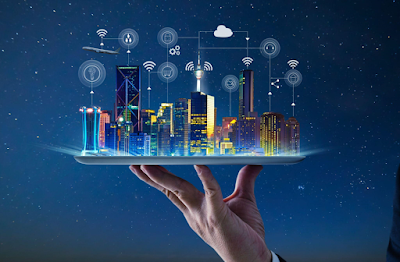In recent years, the concept of smart cities has gained significant traction as urban areas worldwide strive to enhance efficiency, sustainability, and the quality of life for their residents.
At the heart of this transformation lies the Internet of Things, a network of interconnected devices and sensors that collect and share data in real-time. IoT in smart cities has the potential to revolutionize urban living by enabling intelligent infrastructure, optimizing resource management, and fostering citizen engagement.
This article explores the various aspects of IoT in smart cities
and its profound impact on the future of urbanization.
Defining Smart
Cities
A smart city is an urban environment that utilizes digital
technologies and IoT infrastructure to improve the quality of life for its
inhabitants. These cities leverage data-driven insights to optimize resource utilization,
enhance sustainability, and create more efficient and livable spaces.
Components of
Smart Cities
IoT Devices and Sensors
Connected devices and sensors form the
foundation of a smart city, enabling the collection and transmission of data.
Data Analytics
Advanced analytics platforms process the vast amounts
of data generated by IoT devices, extracting meaningful insights for
decision-making.
Connectivity
Robust and reliable communication networks facilitate
the seamless flow of data between devices and systems.
Integration and Interoperability
Different systems and technologies
within a smart city must be integrated and interoperable to ensure efficient
operations and maximize benefits.
Citizen Engagement
Smart cities emphasize citizen participation and
engagement, empowering residents to actively contribute to the decision-making
process.
Intelligent
Infrastructure
IoT enables the creation of intelligent infrastructure systems, such as smart grids, smart transportation, and smart buildings. Smart grids optimize energy distribution, reduce outages, and promote renewable energy integration. Smart transportation systems leverage IoT sensors to manage traffic flow, monitor parking spaces, and enhance public transportation efficiency.
Smart
buildings use IoT technology for energy management, security, and occupant
comfort, resulting in energy savings and improved quality of life.
Environmental
Sustainability
IoT plays a crucial role in enhancing environmental sustainability in smart cities. Sensors deployed throughout the city monitor air quality, water usage, waste management, and noise levels.
This data helps city officials
identify areas that require improvement, implement targeted interventions, and
make informed decisions to mitigate environmental impact. IoT-based solutions
also optimize resource consumption, reduce carbon emissions, and promote
eco-friendly practices.
Public Safety and
Security
IoT enhances public safety and security by enabling real-time monitoring and proactive responses. Connected surveillance systems equipped with video analytics can detect and alert authorities about suspicious activities or incidents. Smart street lighting adjusts brightness based on motion detection and weather conditions, enhancing safety while reducing energy consumption.
Emergency response systems are improved through IoT, enabling
faster and more accurate incident management and resource allocation.
Data Privacy and
Security
As smart cities rely heavily on data collection and processing,
ensuring data privacy and security is paramount. Adequate measures must be
implemented to safeguard personal information and prevent unauthorized access.
Encryption, authentication protocols, and strict data governance frameworks are
necessary to protect sensitive data and maintain public trust.
Interoperability
and Standardization
The multitude of IoT devices and systems in smart cities often operate
on different platforms and protocols. Interoperability and standardization are
crucial to ensure seamless data exchange and integration across various
systems. Adopting open standards and fostering collaboration among stakeholders
are essential steps toward achieving interoperability.
Infrastructure
and Investment
Building a robust IoT infrastructure requires significant investment
in networking infrastructure, sensors, and data management systems.
Collaboration between public and private sectors is necessary to secure
sufficient funding and resources for implementing IoT in smart cities.
Governments and organizations must prioritize infrastructure development and
allocate budgetary resources to support the deployment of IoT technologies.
Improved Quality
of Life
IoT in smart cities offers numerous benefits that directly contribute to an improved quality of life for residents. Efficient transportation systems reduce commute times and ease congestion, enhancing convenience and productivity. Smart energy grids result in reduced utility costs and a more sustainable environment.
Real-time data on air quality and noise levels enables
better urban planning and healthier living conditions. Overall, IoT-driven
solutions enhance citizen well-being and satisfaction.
Economic Growth
and Sustainability
The implementation of IoT in smart cities stimulates economic growth by creating new opportunities for businesses, entrepreneurs, and startups. The integration of technology and data-driven solutions drives innovation, attracting investment and fostering a thriving ecosystem of digital services and products.
Additionally, the optimization of resource management through IoT reduces costs, improves operational efficiency, and promotes long-term sustainability.
Citizen
Engagement and Participation
Smart cities emphasize citizen engagement and participation, empowering residents to actively contribute to decision-making processes. IoT technologies enable citizens to access real-time data, provide feedback, and engage in community initiatives.
Through smart city platforms and mobile
applications, individuals can report issues, suggest improvements, and
collaborate with local authorities, fostering a sense of ownership and collective
responsibility for the city's well-being.
Future
Implications
The integration of IoT in smart cities is an ongoing process with vast future implications. As technology continues to advance, the potential for innovation and transformation in urban environments becomes even greater.
Advancements in artificial intelligence, machine learning, and big data analytics will enable more sophisticated applications of IoT, leading to predictive maintenance, autonomous vehicles, and personalized services.
The concept
of the Internet of Everything, where not only devices but also people and
processes are connected, holds tremendous potential for shaping the cities of
the future.
The integration of IoT in smart cities represents a paradigm shift in urban living. By leveraging interconnected devices, sensors, and data analytics, cities can become more efficient, sustainable, and citizen-centric.
Intelligent infrastructure, environmental sustainability, public safety, and citizen engagement are just a few areas that benefit from IoT-driven solutions. However, challenges such as data privacy, interoperability, and infrastructure investment need to be addressed for successful implementation.
As the world moves toward a more interconnected future, embracing IoT technologies in smart cities will continue to redefine urban living, fostering innovation, and improving the quality of life for millions of people around the globe.
Written by: Manish Kumar





.jpeg)







0 Comments